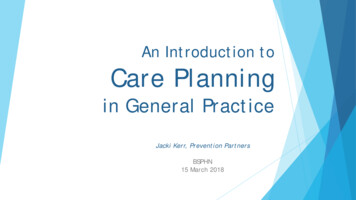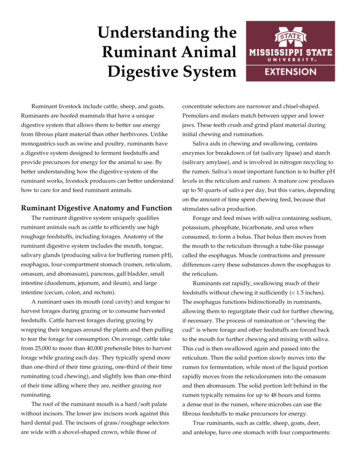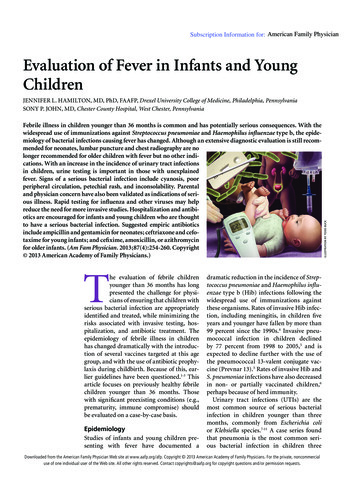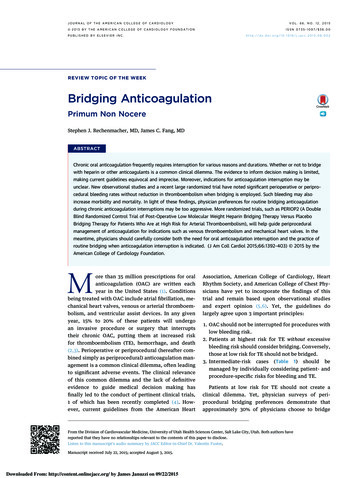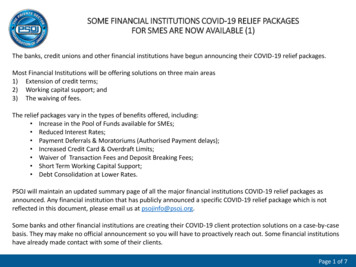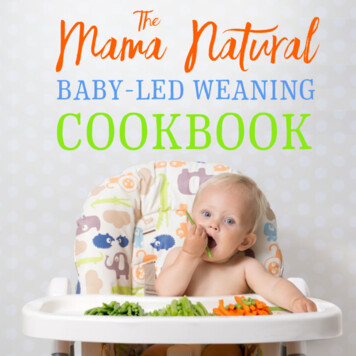
Transcription
8-9 Months
What is Baby-Led Weaning?A Natural Way to Feed BabyBaby-led weaning is the most natural progression from breastfeeding to solid foods.Breastfeeding is also baby’s first lesson in self regulation and baby led weaning continues toallow baby to self regulate food. Baby now gets to experience the many flavors he may havepicked up in his mom’s breastmilk.That doesn’t mean that formula fed babies can’t do baby led weaning. All families can benefitfrom baby-led weaning with some customization.BLW babies: Are encouraged to join the family at mealtime and self-feed appropriate finger foods. Choose what, how much, and how quickly to eat. Are given the freedom to explore new tastes and textures without the pressure to eat a setamount or a specific food. Continue to nurse (or receive a bottle) just as often. Solids are to compliment milk, and babyis trusted to know when to increase solid feedings and decrease milk (usually later in the firstyear).Baby led weaning is nothing new historically.Spoon feeding only became the norm at a time when doctors were advocating starting solidsat 4 month of age (or earlier). We now know that a baby’s digestive system isn’t developedenough to be assimilate solids well at 4 months of age. Waiting until baby is at least 6 monthsold is prudent and often helps to avoid adverse food reactions like spitting up, hives, andeczema.In the mid-19th century, most babies ate solids between 9 and 12 months old. From thetime artificial infant formula was developed in 1867, the accepted age for introducing solidsbecame younger and younger, until the 1950’s and 1960’s when some parents fed infant cerealto babies as little as a few weeks old.Since then, studies show that babies’ digestive tracts are not fully formed until around 6months old and babies should not receive solids before then. Other children, particularlypremature or immunocompromised children may not be ready until 8 or 9 months (more onreadiness later).2
The best part about baby-led weaning is that it is exactly that, baby led. You observe your childfor signs of readiness and, when she’s ready, you prepare nutritious food. Your baby thendecides whether, how much, and what to eat. Your baby gains self-confidence and learns torely on her natural instincts to feed herself exactly what she needs.3
Benefits of Baby-Led WeaningBaby-led weaning is easier. No blenders, no spoons, no wondering if s/he really likes it. Youjust prepare appropriate food for baby to decide to try or not. Simple.It helps develop good eating habits. As we mentioned earlier, baby-led weaning is an extensionof breastfeeding, and continues to allow baby a chance to develop self regulation. This meansthat baby will begin to understand and trust his own hunger and learn how much to eat, whatto eat and when. According to one study, baby-led weaning may set the child up for a healthier BMI inthe future.Self selection of food has even been shown to increase weight in underweight babies,therefore supporting a healthy weight in most babies.Since BLW babies experience a wide range of healthy foods early on, they may bemore likely to continue to enjoy those foods later in life.It’s educational. Food in the first year is for fun. Anyone who’s ever watched babies eatknow they get more on them than in their mouth, and that’s ok.The Right Time to StartAs with all other aspects of growing up, learning to eat, holding utensils, and drinking from acup are developmental milestones that each baby hits at a different time.Baby-led weaning allows baby to learn to feed himself at the exact right time for him.Mealtimes are an opportunity to play and therefore learn about food, what it tastes like, how itfeels. When given the opportunity, baby will learn how to do all of these things on his own andwhen baby is allowed to grow at his own pace he gains self confidence.Signs of readiness include: Baby can sit up well without support. Baby has lost the tongue-thrust reflex (automatically pushing solids out of mouth withtongue). Baby has developed the fine motor skills to self feed (palmar and later, pincer grasp). Baby is willing to chew, even if he has few or no teeth. Baby shows interest in participating at mealtime, and may try to grab food from yourplate and put it in his mouth.4
Consider This Before Starting BLWAs much as baby-led weaning can be a wonderful way to introduce solid foods to baby, thereare some things that every parent should consider before deciding how they’ll feed their baby.Iron and Zinc DeficienciesAround 6 months of age, babies iron stores, that he received from mama in utero, will start todrop (source). If baby had a delayed cord clamping, his stores are probably more robust untilaround 8-9 months of age. Either way, babies do need additional nutrition, outside of justbreastmilk, to boost their iron and zinc levels. That’s why it is important to introduce solids tobaby around the 6-8 month mark.What food is highest in zinc and iron? Meat.Yes, not what we’d expect as the ideal first food for baby! Egg yolk is another good choice.These animal foods are the easiest forms for baby to assimilate (versus fortified cereal grains).As you introduce food, be sure to regularly include stewed meat and gently scrambled eggyolk, combined with some high vitamin C fruits or vegetables like plums and butternut squash,to increase their iron and zinc absorption.5
Weight Gain & Milestone MarkersYou also want to watch baby’s weight and overall milestone development. Some babies maynot get enough solids via self-feeding and will need a daily puree, smoothie, or soup to bolstertheir nutrition. Be sure to include fat-rich foods when making these purees or smoothies likeavocado, whole-fat coconut milk, or some expressed breastmilk.You can let baby “lead” the puree feeding or smoothie drinking so that you’re honoring baby’sappetite and preferences while not overfeeding.Watch for fullness cues such as: turning head,looking disinterested,spitting out foodfussingIt’s Not All or NothingWhile some camps online may position BLW as an all or nothing feeding philosophy, I don’tbelieve it has to be that way.In fact, that’s part of the beauty of BLW. It’s a very intuitive and collaborative experience forboth baby and parent. There may be times that you have to help baby eat. There may be timesthat you want to feed baby directly due to time restraints, bowel issues or nutritional needs.You might have an in-law or relative who prefers puree feeding versus baby-led weaning. Youmay go through phases where all baby wants is smoothies or soups. This is perfectly OK!The point is: Listen, watch and respond to your baby (and your family’s!) needs.If you need to take breaks from BLW, honor that. If you find you get to nervous about chokingwith certain foods (more on that later), ditch them. If 100% adherence to BLW is working foryou, excellent. It’s a very personal and evolving journey.OK, now that we’ve gotten that out of the way let’s talk about what this whole book isabout 6
Starting Baby-Led WeaningSharing MealtimeBaby-led weaning families are encouraged to eat together. Your baby is learning from you allthe time and mealtime is no different. When you eat with your baby, she is getting a chance tolearn by observation and imitation (which she loves to do!) how to eat, what to eat, and howmuch.Your baby will appreciate getting to explore the same (appropriate) foods that the rest of thefamily is eating.Choosing FoodOrganic fruits and vegetables are an obvious best choice but can rack up a big grocery bill fast.If you can’t buy all organic stick with conventional produce from the clean 15 list and splurgeon organic from the dirty dozen. Some parents will compromise by buying conventionalproduce but removing the peel before serving.When it comes to meat, organic, pasture raised animals are the best. When you can’t get all ofyour meat pasture raised stick with organic, pastured organ meats (since they are cheaperanyway) and higher fat ground beef and chicken thighs.When compromising on conventional meat, stick with lean cuts of beef, pork and chicken, orbetter yet, reach for some lamb since conventional lamb is usually pasture raised until the end(when they may be finished on grain).Fish should be wild caught and only low mercury varieties. Canned (in water) works when youdon’t have access to fresh.Fat is essential for optimal health. Whenever possible it’s best to use butter from pasturedcows. Expeller pressed coconut oil works as a butter replacement if you are holding off ondairy. Lard and tallow from pasture raised animals is also an excellent source of healthy fats.Olive oil is excellent, but do your homework to ensure it’s real.7
Preparing FoodFollow your baby’s lead and watch what skills she has mastered or is working on to decidewhat foods are most appropriate. While your baby is still working on the pincer grasp, you’llwant to stick with food that is a shape, size, and texture that she can pick up. That typicallymeans sticks, strips, and wedges of soft foods, but not anything too slippery.You can also begin adding a little seasoning to your baby’s food. Many real food advocatesbelieve a little bit of sea salt is ok. Garlic, turmeric, cinnamon and many other spices are greatand will help expand baby’s palate.Generally, food should be soft enough to be gummed and long enough so baby can grasp withher palm and still eat the ends that poke out. Sticks, strips, wedges and finger are all greatshapes for baby’s first foods.8
FruitsYou’ve probably heard the old wives tale that you shouldn't feed fruit to a baby until she learnsto eat her vegetables. The idea being that once she tastes sweet she won’t want anything else.However, baby has already been eating sweet food: breastmilk!Biologically we are wired to prefer sweet foods because they are more scarce in theenvironment. But just because we prefer them, doesn’t mean we won’t eat anything else.Fruit is a great choice for first food because many fruits are already soft enough for a baby newto solids, which makes them quite convenient.Fruit should be sliced into wedges or strips so baby can pick them up easily. Each pieceshould be about 2 inches long and ½ inch wide. Wedges can be wider if they are cut thinly. Forfruits that are slippery, like avocado or banana, you may want to roll them in a bit of shredded(unsweetened) coconut or nutritional yeast flakes.Harder fruit such as apples and unripe pears can be gently cooked so they are soft enough forbaby. Skins should be removed before 8 months of age.Fruit with inedible rinds are actually wonderful for baby. She has a nice firm handle to hold thefruit and learns quickly not to eat the rind.Round fruit, such as blueberries and grapes, should be introduced after baby has developedthe pincer grasp and should be cut in half or quarters to prevent a choking risk.VegetablesFull of vitamins, minerals, and complex carbohydrates, vegetables are a great first food forbaby. Most vegetables will need to be cooked in order to be soft enough for baby’s mouth andgentle enough for her digestive tract. Vegetables can be boiled, steamed, roasted or baked.Again, sticks and strips work best so that baby can grab with her fist but still have some pokingout to nibble on. Winter squashes like butternut and acorn, as well as sweet potatoes, yams,and peas are all great choices.Some raw vegetables are suitable for your baby as he gets older. Cucumbers can be slicedinto easy to hold sticks and tomatoes can be wedged or sliced as well.9
MeatMeat is another highly nutritious food for baby.Ground beef is easy for baby to eat, either in patties or meatballs. Chicken is also an easychoice. Cut chicken in strips, with the grain, so that it stays together and baby can gnaw on it.Thigh meat can be cut into strips or baby can chew it right off the bone (just be sure therearen’t any small bones or loose gristle).Other cuts of beef, lamb, or pork should be stewed or slow cooked for the most tender meat.Organ meats are another excellent choice for baby due to their high nutrient content, thoughslightly more difficult for baby to eat. Start by adding organ meats into other foods like gratedin an egg yolk or ground up with beef for burgers.Fish is generally considered safe for babies after their first birthday. Fish (low mercury types)can be chopped or crumbled into appropriate sized pieces.Bone broth is a highly nutritious derivative of meat that baby led weaning babies can absolutelyenjoy. Offer bone broth or bone broth soups with a straw or piece of bread to sop with.FatsSince breastmilk is full of fat, healthy fats added to baby’s diet is a great choice. These fattyacids help to feed their brains, nervous systems, developing eyesight and hair, skin and nails.Good choices include avocado, whole coconut milk, and cream and butter added to cookedvegetables and fruit.DairyThough dairy from healthy cows can be a nutritious snack many parents choose to hold off onintroducing dairy until after the first birthday to avoid allergies or intolerances with theexception of yogurt. Because it’s fermented, yogurt is generally easy to digest andwell-tolerated by most children at 9 months or older.As child gets older, cottage cheese, cream cheese, and sour cream can be used in spreads.Hard cheeses can be cut into slices or sticks for easy grasping.10
GrainsMany parents also hold off on introducing grains until after the first birthday. Not only do grainssometimes pose an allergy risk, they are also not as densely nutritious as some other foodsand are unnecessary in the first year. If you do choose to offer grains in the first year stick withrice (sushi rice works well) and soaked oatmeal or oat bread (sliced into strips).Introducing grains in the form of homemade breads, pasta, oatmeal, and the like is mucheasier in the second year. Baby will be gaining more self-feeding skills and will be able tonavigate new shapes and textures. Cut bread into strips. Choose large pasta shapes. Cuthomemade baked goods into strips as well.11
Offering FoodSolid foods in the first year are for fun. Baby still gets most of his calories from breastmilk (orformula). Solid foods should be offered when baby is not hungry or tired. Many moms find itworks best to nurse baby before offering table foods.Be sure to offer a variety of foods so baby gets a chance to explore (and learn to enjoy) manydifferent nutritious meals. Give baby one or two pieces of a few different foods for a variety oftastes and textures without overwhelming her. Be sure to include food that she’s already triedand can handle easily with new and more difficult to handle food to avoid frustration.Remember, this is a learning experience and you want her to have fun!If at all possible, offer baby what you’re eating. Baby wants to be included and loves to try thesame things she sees you eating.The key to baby led weaning is to follow your baby. By placing food in from of her you aregiving her the choice of which food to pick up and whether she will lick it, squish it, smash it, oreat it. Allow her to eat what she wants and how much or little she wants. Let her learn to trusther body. When given a variety of foods to choose from, baby will naturally choose the onesthat meet her nutritional needs.ToolsYou don’t need a lot of equipment to start baby-led weaning, in fact you may need less. Nospoons, no potato masher or blender, and no measuring.To get started you need a safe place for baby to sit upright (unassisted) like a high chair but aparent’s lap can work too. High chairs that pull up right to the table are great for including babyin mealtimes. You will need a clean surface to put baby’s food on. A high chair tray or aplacemat for the table are good choices. Many babies will get distracted by a bowl or plate soit’s best to avoid them for now.You may find that a set of toddler silverware is useful. Offer them to baby but don’t expect himto use them properly, or at all, right away. This is another learning experience and usingutensils will come with time.12
SafetyChoking is a real concern with any supplemental feeding, which is why close supervision iscritical. That said, there needs to be a distinction between gagging – which is a safetymechanism that safeguards against choking by bringing large pieces of food forward to bechewed – and real choking.As baby grows, the place in her mouth that triggers the gag reflex moves further back towardsthe throat. According to Rapley, this is one reason why baby-led weaning is valuable, becausebaby learns to chew and swallow when this reflex is still very close to the front of the mouth. Ofcourse, for all parents, understanding the signs of choking and knowing how to respond is veryimportant. Contact your local hospital or community center to find classes.Foods to avoid High choking risk foods like: grapes, cherry/grape tomatoes, nuts, whole hot dogs. (Youcan find a full list here.)Allergic foods like: gluten, egg whites, nuts (peanuts), seafood, and citrus, especially ifyou have family history of sensitivityAdded table salt* or sugarUnhealthy and processed foods like: chips, popcorn, sugar-containing foods, breakfastcereals, gum, and hard candy.HoneyStimulants: like chocolate or sugarOkay, on to the recipes!13
6-7 Months
Thyme roasted carrotsServings: 2 adult and 1-2 babyIngredients 1 lb fresh carrots, peeled and cut into 1½ in sticks1 tbs. olive oilSea salt and freshly ground black pepper to taste (optional)2 teaspoons fresh chopped thyme or 1/2 teaspoon driedDirections1. Preheat the oven to 425 degrees.2. Combine the carrots, olive oil, salt, pepper and thyme in a large bowl and toss to coat.Transfer the carrots to the prepared baking sheet and roast, stirring once or twice, untilnicely caramelized and tender, 20-25 minutes.3. If you prefer to leave salt out for baby, simply add salt to your own after it comes out of theoven.15
Avocado Slices withNutritional Yeast FlakesServings: 2 babyIngredients: ½ avocado cut into slices2 tbs. nutritional yeast flakesDirections:1. Roll avocado slices in nutritional yeast and serveimmediately.Banana Slices withNutritional Yeast FlakesServings: 2 babyIngredients: ½ banana cut into sticks2 tbs. nutritional yeast flakesDirections: Roll banana sticks in nutritional yeast and serve immediately.16
Mint Green BeansServings: 2 babyIngredients: 6-8 green beans, trimmed1 tsp. fresh mint leaves, chopped1 tsp. butter or coconut oil, meltedDirections: Steam green beans in a steamer basket until soft, about 3-5 minutes. Toss with mintand butter. Serve warm or cold.17
Plum SlicesServings: 1-2 babyIngredients: 1 ripe plum, peeled and cut into wedgesPinch cinnamonPinch fresh gingerDirections:Sprinkle spices on the plum wedges and serve.Cumin and Garlic BeefServings: 2 adult and 1 babyIngredients: ½ lb grass-fed organic ground beef1 ½ tsp. garlic powder1 tsp. cuminDirections:1. Mix spices into ground beef.Form into small patties and cook over medium heat until cooked through.18
Spiced Carrot CoinsServings: 2 babyIngredients: 1 Carrot, cut into coins1 tsp. butter or coconut oilPinch cuminPinch fresh gingerDirections: Steam the carrot coins in a steamer basket until soft, about 10-15 minutes. Toss carrotswith butter and spices. Serve warm or cold.19
Pear SlicesServings: 2-3 babyIngredients: 1 pear, peeled and slicedDirections: Steam pear in a steamer basket for 10-12 minutes or until soft.Cinnamon Acorn SquashServings: 4 adult and 2 babyIngredients: 1 acorn squashButter or coconut oilcinnamon to tasteDirections:1.2.3.4.Preheat oven to 425 degrees.Butter or oil a baking sheet.Halve squash crosswise. Scoop out and discard seeds.Set squash halves, cut sides down, on baking sheet. Bake until golden, 20-25 minutes.Remove from oven and allow to cool.5. Using a sharp knife cut the squash into sticks and remove skin. sprinkle somecinnamon on the squash sticks and serve.20
Butternut SquashServings: 4 adult and 2 babyIngredients: 1 butternut squashButter or coconut oilthyme and garlic powder to tasteDirections:1.2.3.4.Preheat oven to 425 degrees.Butter or oil a baking sheet.Halve squash lengthwise. Scoop out and discard seeds.Set squash halves, cut sides down, on baking sheet. Bake until golden, 40-45 minutes.Remove from oven and allow to cool.5. Using a sharp knife remove skin and cut the squash into sticks. sprinkle garlic powderand thyme on the squash sticks and serve.21
Rosemary CarrotsServings: 2 adult and 2 babyIngredients: 6-8 large carrotsolive oil1 sprig rosemary, choppedDirections:1. Preheat oven to 400 degrees.2. Cut carrots in half at an angle.3. Toss with olive oil and rosemary.Steamed Sweet PotatoesServings: 1 adult and 1 babyIngredients: 1 sweet potato, peeledbutter or coconut oil, meltedDirections:1. Cut sweet potato into long sticks.2. Steam sweet potatoes for 15-20 minutes until soft.3. Rizzle with butter and serve.22
Roasted ZucchiniServings: 2 adult and 2 babyIngredients: 1 large zucchini, cut into long sticksolive oilthyme to tasteDirections:1. Preheat oven to 450 degrees.2. Toss zucchini in olive oil and thyme and place on a baking sheet.3. Bake for 30 minutes, tossing halfway through.23
Slow Cooker ChickenServings: 2 adult and 2 baby with extra for leftoversIngredients: 6-8 boneless chicken thighs1 cup homemade chicken stockDirections:1. Place chicken thighs on the bottom of the slow cooker.2. Pour stock over chicken and cook on low for 4-6 hours.Use a fork to pull chicken into easy to hold pieces.Soft Cooked ApplesServings: 2-3 babyIngredients: 1 apple, peeled and slicedCinnamonDirections:1. Steam apple in a steamer basket for 10-12 minutes or until soft.2. Sprinkle with cinnamon before serving.24
Steamed PumpkinServings: 2 adult and 2 baby with leftovers to freeze or storeIngredients: 1 pie pumpkinCinnamon, ground ginger, and nutmeg to tasteDirections:1.2.3.4.Peel the pumpkin and discard peels.Cut in half and remove stringy innards and seeds.Cut pumpkin into thick sticks and place in a steamer basket.Seam for 30-40 minutes, until pumpkin is soft.Sprinkle spices on top before serving.25
Spiced PeachesServings: 2-4 babyIngredients: 1 very ripe peach, peeled and cut into wedgesPinch cinnamonPinch garam masala (optional)Directions: Sprinkle spices on peach wedges and serve.Garlic ChickenServings: 1 adult and 1 babyIngredients: 1 boneless chicken breast, cut into fingers1 small clove garlic, mincedolive oilDirections:1.2.3.4.5.In a cast iron pan heat olive oil.Cook chicken until browned on all sides.Add garlic and stir.Cook for another few minutes until cooked through.Cut chicken into smaller sticks if needed.26
Easy Boiled Egg YolkServings: 4 eggsIngredients: 4 pastured eggsDirections:1.2.3.4.5.6.Bring 1 inch of water to a boil.Insert steamer basket and eggs.Cover and steam for 7 minutes.Dump out hot water and replace with enough cold water to cool the eggs.Peel and cut eggs lengthwise.Scoop out yolks for baby and eat whites yourself.27
Shredded LiverServings: ManyIngredients: Grass-fed organic beef liverDirections:1. Freeze the liver for 14 days (to kill pathogens).2. Shred into egg yolk, ground beef, etc.Slow Cooker BeefServings: 2 adult and 1 baby with extra for leftoversIngredients: 1-2 lb boneless beef roast, cut into 2 inch sticks (chuck, shoulder or round)2 tbs. olive oil4 carrots, cut into coinsBeef broth to coverDirections:1.2.3.4.Place carrots in slow cooker.Put meat on top of carrots.Add broth to cover meat.Cover and cook on low for 7-8 hours.28
Rosemary LambServings: 2 adult and 1 babyIngredients: ½ lb ground lamb1 tsp. rosemary, finely choppedDirections:1. Mix rosemary into ground lamb.2. Form into small patties and cook over medium heat until cooked through.29
Liver and Sweet PotatoServings: 1 babyIngredients: 1 small piece of liver (around 1 tbs. in size)1/2 small sweet potato, peeled and diced1/2 cup homemade chicken stockDirections:1. Place the liver and sweet potato dice into a small saucepan and pour in the stock.2. Bring to the boil, then lower the heat and simmer for 5 to 8 minutes, until the sweetpotato dice are tender and the liver is done. Be careful not to overcook.Steamed Apple PumpkinServings: 2 adult and 2 baby with leftovers to freeze or storeIngredients: 1 pie pumpkin1 apple, cored, peeled and dicedCinnamon, ground ginger, and nutmeg to tasteDirections:1.2.3.4.5.6.Peel the pumpkin and discard peels.Cut in half and remove stringy innards and seeds.Cut pumpkin into thick sticks and place in a steamer basket.Seam for 25-30 minutes.Add apple and continue to steam for another 8-10 minutes, until soft.Sprinkle spices on top before serving.30
Apple ChickenServings: 1 adult and 1 babyIngredients: 1 chicken breast¼ - ½ cup unsweetened applesauceDirections:1. Cut chicken into sticks.2. Brown in a frying pan over medium heat.3. Add apple sauce and cook through.31
8-9 Months
Banana pancakeServings: 1 adult and 1-2 babyIngredients: 1 ripe banana4 egg yolks (or 2 whole eggs)Direction:1. Mash the banana and egg together.2. Fry in coconut oil or butter over medium heat until set.3. Serve with additional butter or coconut oil and fruit.33
Plum SalsaServings: 2 adult and 2 babyIngredients: 4 ripe plums, peeled and cut into slices1 small cucumber peeled and cut into sticks2 tbs. fresh cilantro or parsley, choppedpinch of fresh grated ginger1 clove garlic, mincedDirections: Toss ingredients in a large bowl and refrigerate for an hour before servings.Easy Turkey SausageServings:1 adult and 1-2 babyIngredients: 2 cups leftover turkey (or chicken), shredded2 egg yolks (or 1 egg)1 apple or pear, shredded, chopped, or mashed¼ cup dried apricots or prunes (unsulphured), choppeda pinch each of rosemary and thymesalt to taste (optional)Directions:1. Mix ingredients and form into patties.2. Fry in pastured lard or butter until set.34
Roasted CauliflowerServings: 2 adult and 1-2 babyIngredients: 1 head of cauliflower, cut into 1 inch florets1 tsp ground cumin½ tsp turmericsalt to taste (optional)Olive oilDirection:1. Preheat oven to 425 degrees.2. In a large bowl toss cauliflower with enough olive oil to coat. sprinkle spices on top andtoss again.3. Place cauliflower on a baking sheet and roast for 25-30 minutes until lightly browned.Serve whole florets to baby. The stalk makes a great handle.35
Banana and PeachesServings: 2 babyIngredients: 1/2 ripe banana1/2 very ripe peach1-2 tbs shredded coconutpinch of cinnamonDirection: Slice the banana into 2 inch long slices that are about ¼ - ½ inch thick.Slice the peach into ¼ inch thick wedges.Sprinkle both with cinnamon and coconut.Carrot OmeletServings: 1 babyIngredients: 1 egg yolk1 tbs shredded carrota pinch black pepperDirection:1. Mix egg yolk with carrot and black pepper.2. Fry in butter or coconut oil on both sides until set.36
Sweet Potato FriesServings: 2 adult and 1-2 babyIngredients: 2 sweet potatoesOlive oil to coatDirections:1.2.3.4.Preheat oven to 350 degrees.Peel the sweet potato and slice into ¼ inch sticks.Toss in olive oil and spread on a baking sheet.Bake for 15- 20 minutes until fries begin to get crispy.37
Hard cooked egg yolkServings: 2 babyIngredients: 1 egg yolkDirection:1. Lightly beat the egg yolk in a bowl.2. Fry in coconut oil or butter for a few seconds on each side until set.3. Slice into strips.Shredded Chicken and PearsServings: 2-3 babyIngredients: Leftover chicken, shredded¼ very ripe pear, sliced2-3 strips of green bell pepperDirection: Toss ingredients and serve cold.38
Fruit CompoteServings: 2-3 babyIngredients: ¼ cup dried apricots (unsulphured), chopped1 apple, peeled, cored and sliced1 pear, peeled, cored and sliced2 cups waterDirection:1.2.3.4.Place ingredients in a saucepan.Bring to a boil and reduce heat to simmer.Simmer for 20-30 minutes.Serve with dippers, or spread on a flatbread.Apple OmeletServings: 1 babyIngredients: 1 egg yolk1 tbs shredded apple (or leftover fruit compote)Direction:Mix egg yolk with fruit. Fry in butter or coconut oil on both sides until set.39
Melon SaladServings: 2 adults and 1 babyIngredients: ½ cup of watermelon½ cup cantaloupe½ cup honeydew melon1 sprig of mint chopped finelyDirection:1. Slice each melon into 2 inch long strips that are about ½ inch thick.2. Sprinkle the chopped mint over the top and let sit in the refrigerator for an hour.40
Avocado, Peach, and CantaloupeDessertServings: 2 adult and 1-2 babyIngredients: 1 avocado, sliced into strips1 ripe peach, sliced into thin wedges1 cup of cantaloupe, sliced into sticks2 tbs. papaya nectarDirections: Toss all ingredients in a small bowl and refrigerate for 1 hour before serving.Squash and Papaya SaladServings: 2 adult and 1-2 babyIngredients: 1 cup butternut squash, cut into 2 inch long sticks2 tbs olive oil1 cup papaya, cut into 2 inch long sticks1 small shallot, diced (or onion)2 cloves garlic, mincedSalt and pepper to taste (optional)Directions:1.2.3.4.5.6.Bring a medium pot of water to boil.Add butternut squash and cook until tender.Drain and set aside.Heat the olive oil in a skillet over medium heat.Add butternut squash, papaya, shallot, and garlic.Cook for a few minutes until heated through.41
Pumpkin Spice FlatbreadsServings: 1 adult and 1-2 babyIngredients: 1 tbs. coconut flour1 1/2 tsp. grass-fed gelatin3 tbs. well cooked and mashed pumpkin1 tbs. butter or coconut oil3 egg yolkspinch cinnamonpinch nutmegpinch sea saltDirections: Allow ingredients to warm to room temperature.Preheat the oven to 400 degrees and line a baking sheet with parchment paper.In a small bowl, stir together the coconut flour and gelatin.In another bowl, stir together the pumpkin and the butter until smooth. Stir in thecoconut flour/gelatin mixture until combined, then stir in the egg yolks, and season
Benefits of Baby-Led Weaning Baby-led weaning is easier. No blenders, no spoons, no wondering if s/he really likes it. You just prepare appropriate food for baby to decide to try or not. Simple. It helps develop good eating habits.




